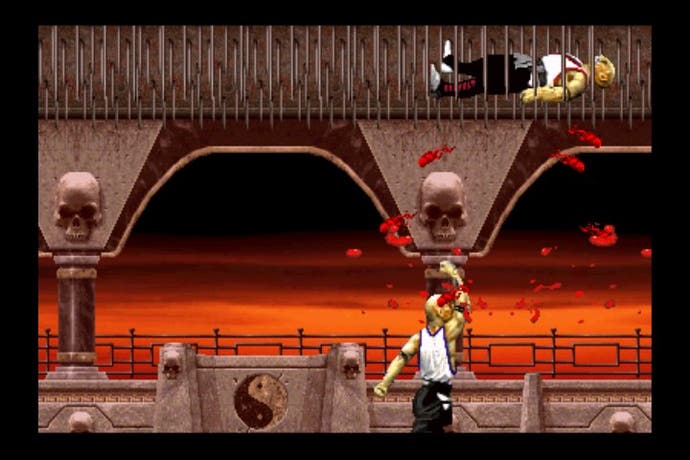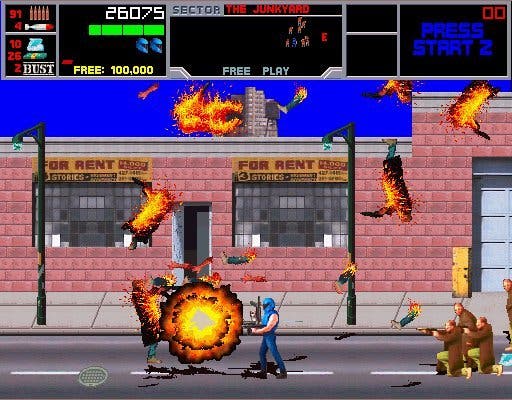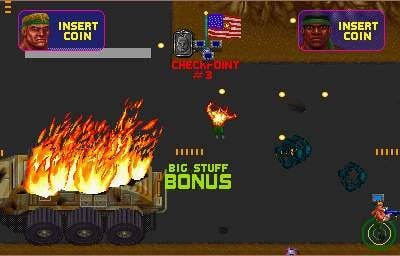Midway Arcade Treasures 2
Another dose of misty-eyed retro nostalgia, or a barrel-scraping exercise?
Order yours now from Simply Games.
Misty-eyed old nostalgists that we are, we really miss the pioneering spirit of the Arcade, with its capacity to surprise, tempt and tease, offering us gaming experiences that were often years away from entering our homes. It was the Tomorrow's World for the gaming scene, and made you realise just how limited your home computer really was. But at the same time, even in our tender years we could recognise that many - if not nearly all - of these games were designed to kick you off as soon as possible, with the intention of extracting as much coinage from your limited funds as possible.
It was always the same cynical formula. Give the gamer a good few minutes of sanity, and then make sure they lose a life or two by virtue of an annoyingly hard boss, and repeat until the 'Continue?' screen pops up. It gradually dawned on us that games designed for our humble home machines were often more fun. Who needed flashy graphics anyway?
Buried treasure

Stripped of their money making purpose and technical advantage, many of the 20 games stuffed into the second Midway Arcade Treasures collection (comprised of Atari, Williams and Bally Midway games) feel hopelessly out of their depth. Most of them didn't even figure that strongly when they were first released, and in the harsh light of 2004 appear laughably out of their depth, while even those that were a success back in the day provide little more than nostalgia or curiosity value.
But there are some diamonds that even now provide genuine entertainment, and these are the ones, generally, that stuck to the strengths of their era rather than trying to show off. Top of the pile has to be Atari's excellent Championship Sprint from 1986, a two-player top-down racing game that looks as basic a game as there's ever been, but has a superbly simple yet addictive premise that the years haven't eroded.
Although 1984's Timber was never a big hit in Europe, it's undoubtedly one of the rare gems on this compilation that stands out as a great game in its own right. Taking the moustachioed character from Tapper, the basic idea was to chop a set number of trees in a time limit, while avoiding a variety of aggressive nasties. With that same frantic gameplay and graphical style as Tapper it instantly won us over. We'll be back for more.
"Gaaaaaame Oveerrrrrrrr"

Another rather overlooked title of the era is APB from 1987, a game built with the same hardware as Paperboy, and sharing a similar gameplay structure and feel. Sharing the same top-down viewpoint as the original Grand Theft Auto, the premise was to pick up a set number of criminals in your working day while avoiding crashing into them. Sounding your siren brings up a targeting reticule which then has to be placed over their car to bring them to justice. It's tricky, exacting, but a lot of fun. Even the legendary Wizard Of Wor from 1980 has a certain true back to basics retro appeal that you can't help but admire. With its eery speech samples ("In Insert Coiiiin"), crazy booming theme tune and incredibly basic graphics it's hard not to be slightly moved by how much things have progressed since. Shoot-'em-up, line of sight maze gameplay might not sound anything special, but it's a museum piece, it really is. We want ironic T-shirts with Burwors, Garwors, and Thorwars on them, please.
Another surprise inclusion that we'd never actually played before was Wacko, another game to utilise the Tapper hardware, and another great little twist on the shoot-'em-up, featuring a bunch of roaming enemies that can only be blitzed when you've matched them up with their twin. Simple, hectic, but fun.
Onto the better known (to us) games, the likes of Total Carnage and Primal Rage don't feel that old and hence don't really generate the same sense of nostalgia. By the early 90s everyone was either going for tons of sprites on screen at once, or using the processing power towards giant characters with loads of animation and detail. Williams' Total Carnage, the spiritual follow up to the madcap Smash TV, followed the former principal, allowing for eight-way fire and the most insane number of enemies ever seen in a game - think Serious Sam, but from an isometric viewpoint. We didn't really like it much at the time, and although it's perfectly playable now, it suffers from the whole "kill you off and make them continue" formula that we hate with a passion.
Primal Kombat

Primal Rage, on the other hand, is easily PlayStation quality, and a perfectly serviceable beat-'em-up, but suffers from there having been about 200 similar games since that have outclassed it in every way. Time is cruel to the popular genres, and while the million of Mortal Kombat fans will delight in the knowledge that MK2 and MK3 are present, both have been available elsewhere for some time anyway, and their inclusion here serves to remind us why arcades became gradually less exciting places to be, and why the likes of the PlayStation became so dominant - the fact being you play them at home with virtually no discernable loss of quality.
The game that kicked off the whole digitised character fad was Pitfighter in 1990, but it suffers now for the same reason it suffered then - it's a dog of a game, with an almost ludicrous lack of animation contributing to terrifyingly sluggish gameplay. Another game that tried to push the technical envelope that doesn't stand up today was the frankly awful NARC from 1988 - a bog standard side scrolling shooter that the world and his dog were churning out back then, and brings back horrible memories of Ocean applying some tenuously linked brand to the gameplay formula. Make it stop.
Another questionable inclusion is 1997's Rampage World Tour, which sticks to the building-smashing gameplay formula of the original, but now lets you smash the buildings from above. We didn't enjoy the original all that much, and this one is prettier, but no less mindless. One original we did love to bits was Spy Hunter - but not so the included sequel from 1987, which is an object lesson in how to kill a brand. Using possibly the worst 3D representation in history, it's a wobbly, unplayable travesty of a game, taking the basic gameplay formula of the 1983 original but crushing it under the weight of terrible implementation. Forced split-screen was also a bad idea. Begone!
And now for the noble experiments

And while we're on the subject of rubbish 3D, who could forget 1988's awful Hard Drivin', which may well have impressed the geeks back then with its groundbreaking filled 3D representation of driving, but in today's language it's just sluggish, the handling is possibly the worst ever in any driving videogame, and the visuals lack any semblance of style whatsoever. Another attempt at 3D was rather more successful in Xybots, from the man behind Gauntlet, Ed Logg. In essence, although viewed from the third-person, the maze-based gameplay is ostensibly the same as Wolfenstein 3D of some four years later, and is further boosted by the inclusion of two player co-op. Which is nice. Amazingly, although the graphics are of a ludicrously low standard compared to today's efforts, it's remarkably playable, and well worth checking out - if only to foster a certain amount of geeky general knowledge on the genesis of the FPS.
1986's Gauntlet II, meanwhile, many will recall, although being greeted with it these days is a fairly mindless experience. As much as it was among one of the most exciting games around in its era for having four-player co-op gameplay, it quickly gets tiresome these days - especially as the sequel appears to have been made a notch more challenging. There will still be plenty of gamers out there that will insist it's brilliant, but take off those rose-tinted spectacles and you'll see it's aged very badly - and with infinite continues it's more a question of how long you can stick it out.
Scraping the bottom of the barrel we've got some truly forgettable games to round up, starting with the execrable Arch Rivals, a really quite awful basketball game, Cyberball 2072, a fairly unfathomable futuristic take on American Football, Kozmik Kroozr, a very poor shooter from 1982, and three-player side scroller Xenophobe, which would have benefited by not having the screen taken up needlessly when the other players are inactive.
Watered down
All round Midway Arcade Treasures 2 is a calculated attempt to stretch the publisher's extensive back catalogue across more volumes than is strictly necessary. There are about five games out of the 20 that we'd ever want to spend time with again, and another half-dozen modern day fillers that have been usurped massively since, while the rest are just truly awful reminders of why things are better just the way they are. No amount of history lessons, or badly filmed video clips make the package particularly worthwhile, although Xbox Live subscribers might fancy recapturing old glories by uploading their scores onto the worldwide leaderboard. At its budget price you can't really moan too much, and hardy old nostalgists will get a few hours of fun out of it, but for those that weren't around for these originally, you're not missing much. Go for the original Arcade Treasures if you need a retro fix that badly.
Order yours now from Simply Games.








